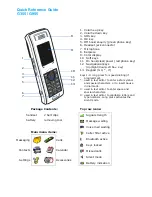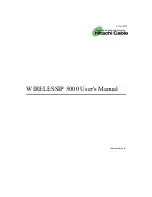
Copyright 2010-2015 Obihai Technology, Inc.
83
The OBi1000 supports both the types of call park described above. The method to use can be set independently for
each SP service, under the ITSP Profile bound to that SP service, with the parameter
ITSP Profile–
SIP
::
X_CallParkMethod
. The
Feature Code
method must be used for the
Park-Against-An-Extension
method,
while the
REFER
must be used for the
Park-In-An-Orbit
method.
With the Feature Code method, the call park feature code must be specified under the same ITSP Profile using the
parameter
ITSP Profile–SIP-Feature Codes
::
Park
. When user presses the “Park” soft key for a highlighted call on
screen, OBi1000 parks the call (in Holding or Connected state) against the local extension of the underlying SP service
by sending a normal INVITE to the number formed by concatenating the call park feature code with the extension
number of the local extension. This INVITE (to park) is sent on the same SP service that the call to be parked is on. Note
that in the context of parking a call, the local extension of the SP service is taken from the parameter
SP
n
Service
::
X_MyExtension
, if it is specified. Otherwise, the normal userid of the SP service is used. The phone GUI does
not have a soft key to park a call against an arbitrary extension - to do that, the user must make another call by dialing
the call park feature code followed by the extension to park against. The burden on the user can be alleviated by
defining a number of speed dials with the feature code+extension pre-configured so the user can simply press the
speed dial key to park the call in one of the pre-defined extensions.
With the REFER method, the OBi1000 parks the call in an orbit by SIP-referring the peer of the call to be parked to the
number that is the orbit to be parked at. This operation is equivalent to that of a blind transfer to a special extension.
When user presses the “Park” soft key of a highlighted call on screen, the OBi1000 pops up a dialog box to ask the user
to enter the orbit number to park the call at. Alternatively, user can simply press the Call Park Monitor feature key of an
unoccupied park orbit to park the call with a single key press. The
Call Park Monitor
feature key is described in the next
section.
Note that the “Park” soft key will not be seen unless the parameter
SPn Service–Network Provided Services
::
CallPark
is enabled.
Call Park Monitor and Call Pickup Methods
Generally speaking, when a call is parked-against-an-extension with a feature code, the user can pick it up by dialing the
call pickup feature code followed by the extension number the call is parked against. To the phone this is just an
ordinary call and it does not need to know, or interpret, the call pickup feature code; the user has the full responsibility
of dialing the feature code and the parked-against extension explicitly and correctly. Similarly when a call is parked-in-
an-orbit and if the soft-switch has a way to allow calls to be picked up from an orbit that is equivalent to making a call
to a special number, users can make those calls without any special support from the phone. There are scenarios when
the OBi1000 can monitor if certain extensions have calls parked against them, or if certain park orbits are holding calls.
For calls parked-against-an-extension, OBi1000 may monitor call park status by directly (SIP) subscribe to an extension’s
call park status (by enabling the option
SPn Service–Network Provided Services
::
CallParkStatus)
, or indirectly
through BLF monitoring of that extension (see the section
Busy Lamp Field
). Note that OBi1000 supports direct
subscription to call park status (in the context an SP service) of the underlying SP’s own extension only, but not an
arbitrary extension. Note also that if the underlying SP is a shared line, then the direct subscription to call park status of
that extension is not necessary if the soft-switch already includes call park status in the notifications of the shared line
status to the phone. The OBi1000 supports call park status subscription by subscribing to the
x-broadworks-callpark
event package, and expects notification that includes an x-broadworks-callpark-info XML document in the message
boxy (Content-Type:application/x-broadworks-callpark-info+xml). Here is an example:
<?xml version="1.0" encoding="UTF-8"?>
<x-broadworks-callpark-info xmlns="http://schema.broadsoft.com/callpark">
<callpark>
<parked>
<identity display="Alice south">
sip:[email protected];user=phone
</identity>
</parked>
</callpark>
</x-broadworks-callpark-info>
Содержание OBi1062
Страница 136: ...Copyright 2010 2015 Obihai Technology Inc 136...
















































